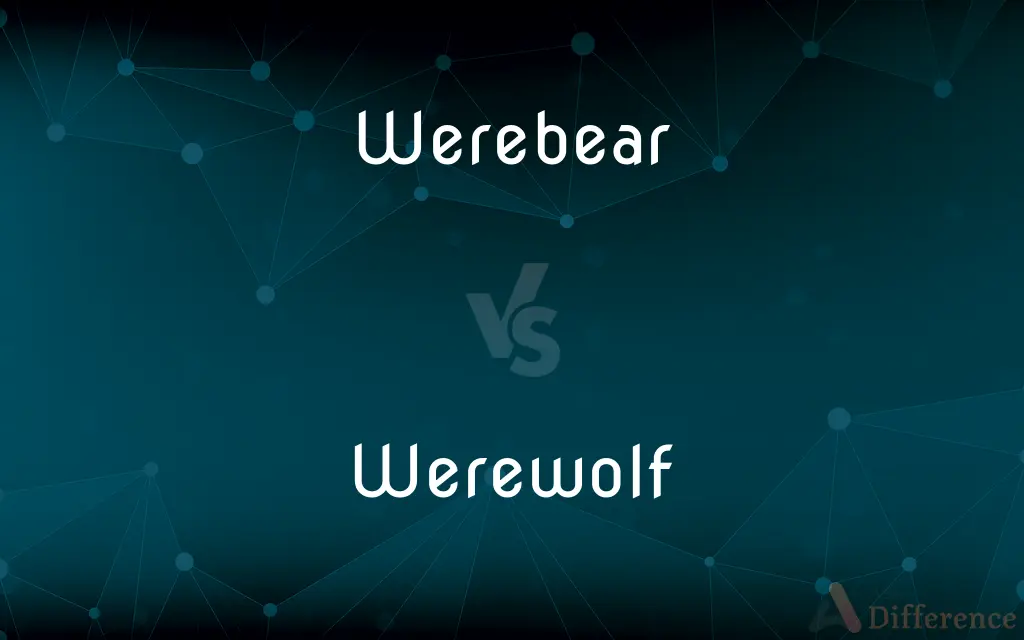Werebear vs. Werewolf — What's the Difference?
By Tayyaba Rehman & Urooj Arif — Updated on April 26, 2024
Werebears are mythical creatures transforming into bears, typically seen as calmer and more protective, while werewolves, transforming into wolves, are often depicted as more aggressive and unpredictable.

Difference Between Werebear and Werewolf
Table of Contents
ADVERTISEMENT
Key Differences
Werebears, found in various folklore and fantasy genres, are creatures that transform into bears, either voluntarily or triggered by specific conditions. On the other hand, werewolves, popular in many cultures' myths, turn into wolves or humanoid wolf-like creatures, generally during a full moon.
In terms of temperament, werebears are usually portrayed as less aggressive and more solitary, often linked with nature and protection. Conversely, werewolves are typically depicted as more ferocious and prone to losing control, representing wildness and the animalistic side of humanity.
Regarding their origins in mythology, werebears are less common and are primarily found in Native American and Norse legends, where they are often revered as powerful spiritual figures. In contrast, werewolves have a more widespread presence in European folklore, where they are often feared and hunted.
In modern media, werebears appear in fantasy novels and role-playing games as characters that combine human intelligence with the strength of a bear. On the other hand, werewolves are frequent figures in horror and fantasy films, books, and television, emphasizing their curse and struggle with their dual nature.
Both werebears and werewolves share the theme of transformation and the dual nature of man, but they are treated very differently in terms of narrative significance and cultural symbolism. Werebears often embody strength and protection, while werewolves symbolize unrestrained primal instincts.
ADVERTISEMENT
Comparison Chart
Transformation
Into a bear
Into a wolf
Typical Behavior
Protective, solitary
Aggressive, pack-oriented
Symbolism
Strength, nature, protection
Wildness, curse, loss of control
Common in
Native American, Norse folklore
Widespread in European folklore
Portrayal in Media
Less common, featured in fantasy
Common in horror and fantasy
Compare with Definitions
Werebear
Appears in modern fantasy as a powerful ally.
In the game, the werebear is a character class known for strength.
Werewolf
Often associated with the horror genre.
The classic werewolf tale involves a bite that curses the victim.
Werebear
Often portrayed as a protector in myths.
The werebear is revered as a protective spirit in tribal stories.
Werewolf
Represents a loss of control when transformed.
The werewolf loses all human consciousness during transformation.
Werebear
A mythical creature that transforms into a bear.
The werebear in the story acts as the guardian of the forest.
Werewolf
Featured in many movies as a central character.
The film explores the tragedy of the werewolf's dual existence.
Werebear
A character in folklore with the ability to become a bear.
According to legend, the werebear could transform at will.
Werewolf
A symbol of unrestrained primal instincts.
In stories, the werewolf often embodies unchecked aggression.
Werebear
Linked with themes of nature and solitude.
The werebear symbolizes deep connections with the natural world.
Werewolf
A creature from folklore that transforms into a wolf.
The werewolf is often depicted as cursed under the full moon.
Werebear
(fiction) A shapeshifter who can change between bear and human form
Werewolf
In folklore, a werewolf (Old English: werwulf, "man-wolf"), or occasionally lycanthrope (Greek: λυκάνθρωπος lukánthrōpos, "wolf-human"), is a human with the ability to shapeshift into a wolf (or, especially in modern film, a therianthropic hybrid wolflike creature), either purposely or after being placed under a curse or affliction (often a bite or scratch from another werewolf) with the transformations occurring on the night of a full moon. Early sources for belief in this ability or affliction, called lycanthropy , are Petronius (27–66) and Gervase of Tilbury (1150–1228).
Werewolf
A person believed to have been transformed into a wolf or to be capable of assuming the form of a wolf.
Werewolf
(mythology) A person who is transformed or can transform into a wolf or a wolflike human, often said to transform during a full moon. Category:en:Horror
Werewolf
A person transformed into a wolf in form and appetite, either temporarily or permanently, whether by supernatural influences, by witchcraft, or voluntarily; a lycanthrope. Belief in werewolves, formerly general, is not now extinct.
The werwolf went about his prey.
The brutes that wear our form and face,The werewolves of the human race.
Werewolf
A monster able to change appearance from human to wolf
Common Curiosities
What is the main difference in group behavior between werebears and werewolves?
Werebears are typically solitary, whereas werewolves may be depicted as part of a pack.
How does a werewolf transformation typically occur?
Werewolves traditionally transform during a full moon or under extreme emotional stress.
What triggers the transformation into a werebear?
The transformation can be triggered by various factors, often involving natural or magical elements specific to the lore.
Can werewolves control their transformation?
In most tales, werewolves have little to no control over their transformations and actions as wolves.
Are werebears considered good or evil in folklore?
Werebears are generally portrayed as protective and benevolent figures, unlike the often malevolent werewolf.
What cultural significance do werewolves hold?
Werewolves often reflect societal fears about what lies beneath the facade of civilization - the untamed and animalistic traits in humans.
Do werebears have any special powers?
In some stories, werebears have heightened strength, durability, and a deep connection with nature.
What vulnerabilities do werewolves have?
Common vulnerabilities include silver bullets, lack of control during transformation, and their animalistic urges.
How are werebears used in modern storytelling?
Werebears are used in fantasy and gaming as characters that combine human intellect with the physical power of bears.
How do perceptions of werebears and werewolves differ across cultures?
Cultural perceptions vary; werebears are often seen as spiritual and protective, while werewolves are viewed as cursed beings needing to be feared or pitied.
Share Your Discovery

Previous Comparison
Evolution vs. Revolution
Next Comparison
Double vs. TwinAuthor Spotlight
Written by
Tayyaba RehmanTayyaba Rehman is a distinguished writer, currently serving as a primary contributor to askdifference.com. As a researcher in semantics and etymology, Tayyaba's passion for the complexity of languages and their distinctions has found a perfect home on the platform. Tayyaba delves into the intricacies of language, distinguishing between commonly confused words and phrases, thereby providing clarity for readers worldwide.
Co-written by
Urooj ArifUrooj is a skilled content writer at Ask Difference, known for her exceptional ability to simplify complex topics into engaging and informative content. With a passion for research and a flair for clear, concise writing, she consistently delivers articles that resonate with our diverse audience.
















































